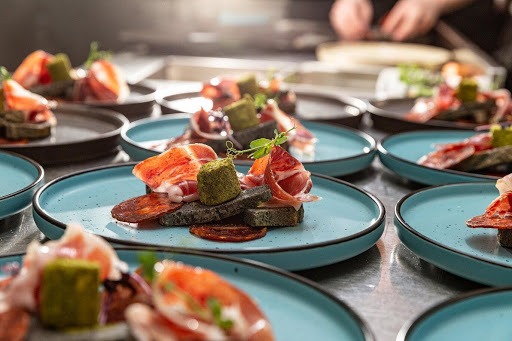
Food plating guide | How to improve plate presentation
What is plating presentation?
Plating presentation refers to the way that food is arranged on a plate, it’s what affords food its visual appeal. Think about when you go to a high-class restaurant and your food is beautifully placed on the plate, that is the pièce de résistance of plating presentation.
Why is plate presentation so important?
What food looks like on the plate dictates how eager people will be to taste the food. There is no point in having the tastiest food in the world if it looks unappealing. Even if your food is mediocre, beautiful plating can trick people into thinking it is far better than it is.
What are the 5 basic elements of plating?
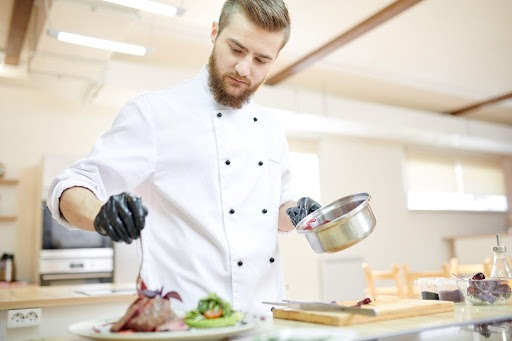
1. Framework
The framework is basically your vision; what do you see the final dish looking like? Sometimes chefs know exactly what they want their dish to look like as soon as the concept of the dish enters their mind. Other times, chefs browse pictures and compare different objects and tableware in order to inspire the final look of the dish.
No matter how you decide to present your food, it’s recommended that you sketch or draw it out first. Drawing it out will help you visualize exactly what you want your dish to look like and will work as a reference point as you begin to construct it. The framework is integral in getting the ball rolling and ensuring you know exactly what you are working towards.
2. Simplicity
The best technique to make sure you don’t get carried away with your presentation is to choose one ingredient as the focal point of the plate. Having a singular aspect of the dish that you can center everything else around will ensure no elements get lost on the plate.
3. Balance the dish
Although simplicity plays a large role in ensuring the diner is not overwhelmed, balancing the dish will also help you in this endeavor. If you can successfully balance the presentation of your dish, you will make sure certain elements don’t get lost and distorted on the plate.
4. Portion Size
When creating your dish, make sure you have an appropriate portion size of all the major food groups included in order to present a nutritionally balanced meal. Once this has been taken care of, you need to make sure the portion sizes are represented accurately on the plate. The plate size itself will help you accomplish this. If you have a larger portion, use a larger plate and vice versa.
5. Highlight the key ingredient
This element has already been touched on, but it’s an extremely important aspect of your food presentation. All dishes have a star of the show, and you will inevitably want to showcase this key element.
Food presentation and plating techniques to plate like a pro
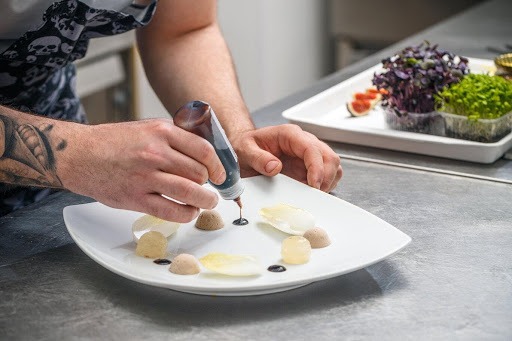
Below are some of the best food plating techniques :
Height
Structural integrity is obviously needed in order to create height with your food, so make you create a base with the bulkiest of your ingredients. For example, a piece of meat or a thick vegetable would work as a brilliant base. Once you’ve chosen a base, simply work up from there.
You can also lean ingredients up against one another (an al dente piece of asparagus is perfect for this) to make things more exciting whilst also encouraging height on the plate. You may need to transform into a bit of an architect for this, but hey the best chefs wear different hats.
Play around with colors
Using brightly colored foods will create aesthetically pleasing visuals that present your dish in an original way. If you’re able to achieve this pop of color without having to artificially alter any of the food, you should definitely do so.
Using things such as matcha, the yellow of an olive oil, bright red chilli or anything alike will allow you to add color without altering the integrity of your flavors.
Another way to ensure the diner is drawn to the color and vibrancy of the food is to leave white space on the plate surrounding the food. This white space works as the canvas to your creation and will contrast the bold colors in the centre.
Sauce plating techniques
Knowing how to present your sauces is a key skill that will help you present your food in the best way possible, leaving no element behind. There are three main types of sauce plating techniques, which are smeared sauce, swirled sauce and accent dots:
- Swirled sauce is fairly self-explanatory. The final look will see your sauce create a spiral design on the plate. In order to achieve this effect, simply squeeze your sauce out of your bottle whilst turning the plate. The smoothest spiral is achieved if you place the plate on some kind of turntable.
- Smeared sauce. In order to achieve this look, you will need to squeeze a thick circular layer of sauce onto the plate and drag it out with a spoon.
- Accent dots are possibly the easiest sauce technique that give a sleek finish to your dish. All you need to do is squeeze out little dots of your sauce onto the plate in whatever design you would like.
There is a lot of creative freedom around what you can do with sauces, so dive into your creative side to develop your own masterpiece.
Dinner plate presentation ideas
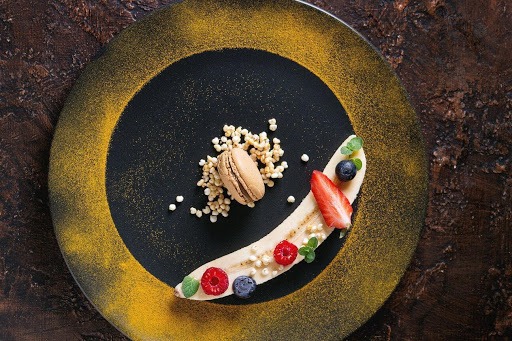
Now that you know a few of the best plate presentation techniques, you have the tools to go wild and create beautiful plates of food. However, if you feel like you could still use some inspiration on how to improve presentation and kick-start your creative process, here are some presentation ideas:
1. Mix up your plate colors
Using a different color plate is a quick and easy way to make your dish look more exciting. However, there is still an art to choosing the right kind of plate.
If the food you are serving is already vibrant and bold, you might want to opt for a duller plate with more muted tones. However, if your food is looking a bit beige and not very exciting, using a bright colorful plate will add that pop of color that your presentation is craving.
2. Garnishes
Not only do garnishes elevate the overall flavor of your dish, they also elevate the visuals of the dish. Simply sprinkle the garnish of your choice on top and voila, you’re done. Depending on the aesthetic you’re going for, you can delicately place your garnish on top of your food in the perfect place. Alternatively, if you’re going for a more rustic look, simply throw it on top and serve it.
3. Create a theme
Designing your plates around your theme does not have to be complicated, the theme itself doesn’t have to be complex, the difficulty level is up to you. For example, your theme could be something as simple as rustic dining. If rustic is your theme, stick to dull toned plates or even veer away from classic plating and serve your food on a chopping board. If your theme is more upscale, you will want to have smaller portions presented with a creative flair and artistry.
How to make your dinner extra special
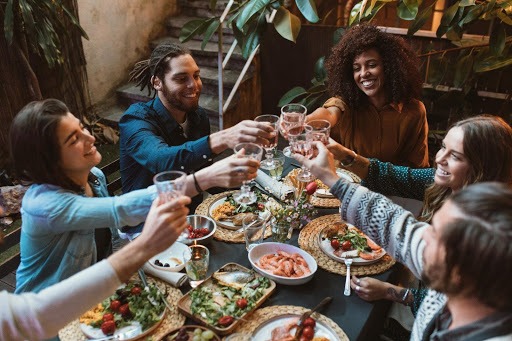
We have gone through how to improve the presentation of your food for your dinner party, so you’re set on that front but there are also other ways for you to make your dinner extra special.
Hiring a private chef will ensure you enjoy delicious food, perfect presentation and an overall brilliant dining experience without any of the stress of having to plan it yourself. Moreover, the personalized experience that personal chefs are eager to create will produce an unbeatable atmosphere. If you want a more interactive activity, you can also book a cooking class and learn plating techniques alongside a professional chef.
